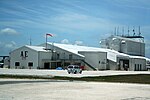Cape Canaveral Space Force Station

Cape Canaveral Space Force Station (CCSFS) is an installation of the United States Space Force's Space Launch Delta 45, located on Cape Canaveral in Brevard County, Florida. Headquartered at the nearby Patrick Space Force Base, the station is the primary launch site for the Space Force's Eastern Range with three launch pads currently active (Space Launch Complexes 37B, 40, and 41). The facility is south-southeast of NASA's Kennedy Space Center on adjacent Merritt Island, with the two linked by bridges and causeways. The Cape Canaveral Space Force Station Skid Strip provides a 10,000-foot (3,000 m) runway close to the launch complexes for military airlift aircraft delivering heavy and outsized payloads to the Cape. A number of American space exploration pioneers were launched from CCSFS, including the first U.S. Earth satellite (1958), first U.S. astronaut (1961), first U.S. astronaut in orbit (1962), first two-man U.S. spacecraft (1965), first U.S. uncrewed lunar landing (1966), and first three-man U.S. spacecraft (1968). It was also the launch site for all of the first spacecraft to (separately) fly past each of the planets in the Solar System (1962–1977), the first spacecraft to orbit Mars (1971) and roam its surface (1996), the first American spacecraft to orbit and land on Venus (1978), the first spacecraft to orbit Saturn (2004), and to orbit Mercury (2011), and the first spacecraft to leave the Solar System (1977). Portions of the base have been designated a National Historic Landmark for their association with the early years of the American space program.Cape Canaveral was known as Cape Canaveral Launch Area upon its foundation in 1949, but renamed to LRPG Launching Area in 1950. It was known as Cape Canaveral Auxiliary Air Force Base from 1951 to 1955, and Cape Canaveral Missile Test Annex from 1955 to 1964. The facility was later known as Cape Kennedy Air Force Station from 1964 to 1974, and as Cape Canaveral Air Force Station from 1974 to 1994 and from 2000 to 2020, taking the designation Cape Canaveral Air Station from 1994 to 2000. The facility was renamed "Cape Canaveral Space Force Station" in December 2020.
Excerpt from the Wikipedia article Cape Canaveral Space Force Station (License: CC BY-SA 3.0, Authors, Images).Cape Canaveral Space Force Station
Samuel C Phillips Parkway,
Geographical coordinates (GPS) Address Nearby Places Show on map
Geographical coordinates (GPS)
| Latitude | Longitude |
|---|---|
| N 28.488888888889 ° | E -80.577777777778 ° |
Address
Air Froce Supply Warehouse
Samuel C Phillips Parkway 1623
Florida, United States
Open on Google Maps











